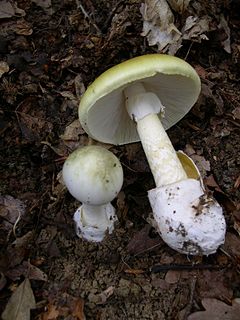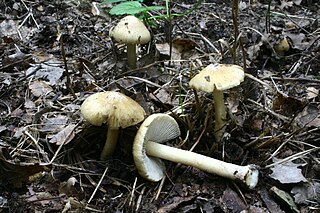
Mushroom poisoning is poisoning resulting from the ingestion of mushrooms that contain toxic substances. Its symptoms can vary from slight gastrointestinal discomfort to death in about 10 days. Mushroom toxins are secondary metabolites produced by the fungus.

Inocybe erubescens, also known as I. patouillardii, commonly known as the deadly fibrecap, brick-red tear mushroom or red-staining Inocybe, is a poisonous basidiomycete fungus, one of many in the genus Inocybe and one of the few known to have caused death. It is found growing in small groups on leaf litters in association with beech. All mushroom guidebooks as well as the mushroomers advise that the entire genus should be avoided. The fruit bodies appear in spring and summer; the bell-shaped caps are generally pale pinkish in colour with red stains, with a reddish-pink stipe and gills.

Entoloma sinuatum is a poisonous mushroom found across Europe and North America. Some guidebooks refer to it by its older scientific names of Entoloma lividum or Rhodophyllus sinuatus. The largest mushroom of the genus of pink-spored fungi known as Entoloma, it is also the type species. Appearing in late summer and autumn, fruit bodies are found in deciduous woodlands on clay or chalky soils, or nearby parklands, sometimes in the form of fairy rings. Solid in shape, they resemble members of the genus Tricholoma. The ivory to light grey-brown cap is up to 20 cm (7.9 in) across with a margin that is rolled inward. The sinuate gills are pale and often yellowish, becoming pink as the spores develop. The thick whitish stem has no ring.

Tricholoma equestre or Tricholoma flavovirens, also known as man on horseback or yellow knight is a formerly widely eaten but arguably hazardous fungus of the genus Tricholoma that forms ectomycorrhiza with pine trees.

Tricholoma magnivelare is a gilled mushroom found East of the Rocky Mountains in North America growing in coniferous woodland. These ectomycorrhizal fungi are typically edible species that exist in a symbiotic relationship with various species of pine, commonly jack pine. They belong to the genus Tricholoma, which includes the closely related East Asian songi or matsutake as well as the Western matsutake and Meso-American matsutake. T. magnivelare is also known as the ponderosa mushroom, pine mushroom, American matsutake.

Agaricus campestris is a widely eaten gilled mushroom closely related to the cultivated button mushroom Agaricus bisporus. It is commonly known as the field mushroom or, in North America, meadow mushroom.

Tricholoma pardinum, commonly known as spotted tricholoma, tiger tricholoma, tigertop, leopard knight, or dirty trich, is a gilled mushroom widely distributed across North America, Europe, and parts of Asia. It is generally found in beech woodland in summer and autumn. Two subspecies have been described from southern Europe. First officially described by Christiaan Hendrik Persoon in 1801, T. pardinum has had a confusing taxonomic history that extends over two centuries. In 1762, German naturalist Jacob Christian Schäffer described the species Agaricus tigrinus with an illustration corresponding to what is thought to be T. pardinum, and consequently, the name Tricholoma tigrinum has been used erroneously in some European field guides.

Inocybe geophylla, commonly known as the earthy inocybe, common white inocybe or white fibercap, is a poisonous mushroom of the genus Inocybe. It is widespread and common in Europe and North America, appearing under both conifer and deciduous trees in summer and autumn. The fruiting body is a small all-white or cream mushroom with a fibrous silky umbonate cap and adnexed gills. An all-lilac variety lilacina is also common.

Leucopaxillus giganteus, commonly known as the giant leucopax or the giant funnel, is a saprobic species of fungus in the family Tricholomataceae. As its common names imply, the fruit body, or mushroom, can become quite large—the cap reaches diameters of up to 50 cm (20 in). It has a white or pale cream cap, and is funnel-shaped when mature, with the gills running down the length of the stem. Considered by some to be a choice edible when young, this species has a cosmopolitan distribution, and is typically found growing in groups or rings in grassy pastures, roadside hedges, or woodland clearings. It has been shown to contain a bioactive compound with antibiotic properties.

Tricholoma saponaceum, also known as the soap-scented toadstool, soapy knight or soap tricholoma is an inedible mushroom found in woodlands in Europe and North America.

Inosperma maculatum, formerly named Inocybe maculata and known in the vernacular as the frosty fibrecap, is a species of mushroom in the family Inocybaceae. First described by Jean Louis Émile Boudier in 1885, I. maculatum is found throughout Europe, Asia and North America. It is a medium-sized brown mushroom with a fibrous, brown cap with white remnants of a universal veil in the middle. The stem is cream or brown. The species is ectomycorrhizal and grows at the base of various trees, including beech. Inosperma maculatum is poisonous, containing muscarine. Possible symptoms after consumption of I. maculatum mushrooms are salivation, lacrimation, urination, defecation, gastrointestinal problems and vomiting, with the possibility of death due to respiratory failure.

Inosperma cookei, commonly known as the straw fibrecap, is a species of mushroom in the family Inocybaceae. It was first described in 1892 by Giacomo Bresadola, and is named in honour of Mordecai Cubitt Cooke. The species is found in Europe, Asia and North America. It produces small mushrooms of an ochre colour, with a prominent umbo, fibres on the cap and a distinctive bulb at the base of the stem. It grows from soil in mixed woodland, and is encountered in summer and autumn, though is not common. Ecologically, it feeds through use of ectomycorrhiza. Inosperma cookei has been described as both toxic and non-toxic, but either way, is not advised for consumption.

Inocybe praetervisa is a small, yellow and brown mushroom in the family Inocybaceae, distinguished from other members of the genus by its unusual spores and bulb. The unusual spores led to the species being named the type species of the now-abandoned genus Astrosporina; recent studies have shown that such a genus could not exist, as the species with the defining traits do not form a monophyletic group. However, it is a part of several clades within the genus Inocybe. I. praetervisa grows on the ground in woodland, favouring beech trees, and is found in Europe, North America and Asia. It is inedible and probably poisonous due to the presence of muscarine. The ingestion of muscarine can lead to SLUDGE syndrome, and could potentially lead to death due to respiratory failure.

Tricholoma portentosum, commonly known as the charbonnier, or sooty head in North America, is a grey-capped edible mushroom of the large genus Tricholoma. It is found in woodlands in Europe and North America.

Tricholoma nigrum is a mushroom of the agaric genus Tricholoma. It was described as new to science in 1996 from a collection made on the Oregon Coast where it occurred with Pinus contorta. It has also been found in an old-growth conifer forest.

Tricholoma vaccinum, commonly known as the russet scaly tricholoma, the scaly knight, or the fuzztop, is a fungus of the agaric genus Tricholoma. It produces medium-sized fruit bodies (mushrooms) that have a distinctive hairy reddish-brown cap with a shaggy margin when young. The cap, which can reach a diameter of up to 6.5 cm (2.6 in) wide, breaks up into flattened scales in maturity. It has cream-buff to pinkish gills with brown spots. Its fibrous, hollow stipe is white above and reddish brown below, and measures 4 to 7.5 cm long. Although young fruit bodies have a partial veil, it does not leave a ring on the stipe.

Tricholoma ustale, commonly known as the burnt knight, is a species of mushroom in the large genus Tricholoma. It is found in Asia, Europe, and North America, though those from North America may represent one or more different species.

Tricholoma pessundatum is a mushroom of the agaric genus Tricholoma. First described as Agaricus pessundatus by Elias Magnus Fries in 1821, it was transferred to the genus Tricholoma by Lucien Quélet in 1872.

Tricholoma sejunctum is a mushroom that appears across much of the Northern Hemisphere and is associated with pine forests.

Cortinarius alboviolaceus is a basidiomycete mushroom of the genus Cortinarius native to Europe and North America.




















